HIRING AND RECRUITMENT TRAINING
FOR YOUR ORGANIZATION
FOR YOUR ORGANIZATION
The Hiring Process and Recruitment Strategies
When anyone is hiring, they want to make sure they hire the best employees to fit their organization’s needs, and there are a few steps involved in the process.When a company decides to hire for a new or open position, the first thing that happens is the development of the job posting. It should be an attention-grabbing, concise job description that includes a specific title, talks about the company culture and values, shares the hard and soft skills needed for the position, and discusses how the role fits into the overall organization.
Once that is completed, HR must advertise that the position is open and accepting applications. It’s smart to begin by notifying current employees of the opening, as an internal hire can save time and money. They are also a vital resource in providing referrals for open positions. Externally, post to niche job boards (JournalismJobs or StackOverflow, for example) as that is where you’ll be more likely to find candidates for specific, skilled jobs. However, the use of mainstream job boards is fine, too, along with a combination of the company’s website and social media platforms and word-of-mouth recruitment.
Developing a recruiting strategy can help you select, attract, and hire the best candidates. These strategies can be implemented during any part of the hiring process. Consider looking at passive candidates. These are prospective hires that aren’t necessarily looking for a job but would leave their current role if presented with a better opportunity. A LinkedIn study found that 70% of the workforce is made up of passive candidates.
Developing Interviewers' Skills
Interviews are a vital component of the hiring process and those conducting them need to be well informed on how to do so effectively. They need to know how to get the desired information from job candidates. Preparing beforehand by training interviewers on useful techniques and best practices is key to the success of the hiring process.
It is important that interviewers are in compliance with state and federal prohibitions on certain types of questions, how to avoid bias and discrimination, and how to structure an interview.
Consider the following when preparing to interview prospective hires:
- Qualities, skills, and experiences needed to succeed in the job role
- Specific questions to elicit needed information regarding experience
- Decide the type of interview (structured – same questions for everyone or unstructured – more open-ended questions)
- Determine who will conduct the interviews
Job Offers
Once the right candidate is chosen, background and reference checks can be completed. These are done to verify what a candidate says on their application. When all of that is cleared, an offer is given to the candidate. Hiring is usually a very direct, pointed process aimed at getting a position filled. Recruiting, however, should be an ongoing operation within any organization.
Recruiting Within the Hiring Process
Recruiting fits into the hiring process but can also be a separate endeavor. Within the hiring process, the recruitment phase occurs by reaching out to candidates through job postings, referrals, advertisements, etc. Recruiters pool together viable candidates and have them at the ready when certain positions open.When someone pops up that would be a good fit – via social media, networking, referrals, etc, – it is a chance to reach out, chat, and talk about your company.
Outside of the hiring process, it should be a continual search for the best employees. This is a chance to build awareness of your company, its culture, and its values among industry professionals, whether they are job seekers or not.
As you speak with more and more people, you can begin forming a list of potential future employees that are already aware of your brand when an opening becomes available.
Cost of Hiring and Recruiting
In 2016, SHRM found that the average cost per hire is $4,129.owever this number can vary from organization to organization. Cost per hire depends on hiring volume, first of all. The more people hired, the lower the cost per hire. Also, some roles and industries take longer to fill (skilled jobs such as engineers and developers). This longer time frame can accumulate costs.
When looking to budget hiring and recruiting costs there are other things to consider besides cost per hire. You’ll need to include any associated job board fees, travel expenses, external recruiting costs, branding, testing fees, internal referral bonuses, and salaries for internal recruiters.
Preview Videos from The BizLibrary Collection
Hiring Crash Course: Conducting an Interview

Hiring Remotely: Recruiting Stellar Applicants

Recruiting, Retaining, and Motivating Part-Time Workers

How Online Training for Hiring and Recruitment Can Help
Being aware of current trends and tactics within hiring and recruiting, how to handle interviews remotely and in person, and how to spot high-potential employees are important skills for driving in well-qualified new hires.
BizLibrary curates a large and diverse video training library with numerous courses focused on developing hiring, recruiting, and interviewing knowledge and skills.

Explore more
of our compliance
training topics.
Online training is quickly becoming the best way to teach employees skills they need to do their jobs. Numerous studies have shown that online training is often more effective, and learners retain more information than with classroom training alone.
Our micro video format breaks content up into smaller, more manageable chunks, making it easier for employees to learn and apply this knowledge when they need it. These online courses can be viewed on an individual basis – where an employee learns by themselves at work or at home – or as part of a group training environment or discussion.
Help your organization hire the best and brightest by utilizing modern, engaging training content in an easy-to-use platform. Talk with an expert to learn how our online learning solutions can transform training in your organization.
